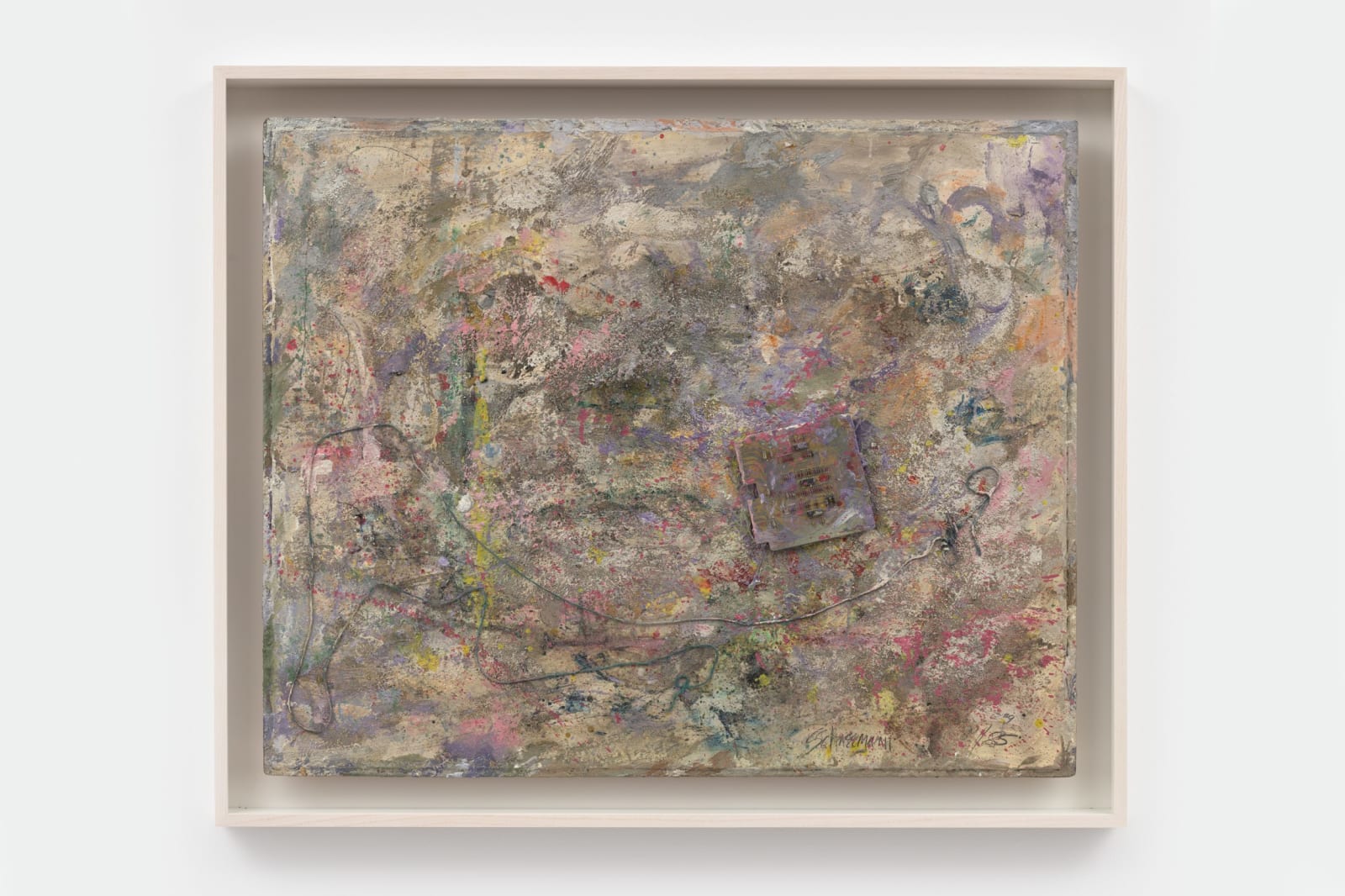
Carolee Schneemann
Untitled (Dust Painting IX), 1985
Acrylic, soot, dust, ashes, plastic, circuit-board, string, pencil, and paper on plywood
83.8 x 104.1 cm
33 x 41 in
Framed: 96.2 x 116.5 x 8.9 cm
37 7/8 x 45 7/8 x 3 1/2 in
33 x 41 in
Framed: 96.2 x 116.5 x 8.9 cm
37 7/8 x 45 7/8 x 3 1/2 in
Carolee Schneemann (b. 1939, Illinois) received a B.A. from Bard College and an M.F.A. from the University of Illinois. She holds Honorary Doctor of Fine Arts degrees from the California...
Carolee Schneemann (b. 1939, Illinois) received a B.A. from Bard College and an M.F.A. from the University of Illinois. She holds Honorary Doctor of Fine Arts degrees from the California Institute of the Arts and the Maine College of Art. Schneemann examines themes of viscerality, identity and gender through painting, performance, installation and photography.
For over five decades – from her groundbreaking anti-Vietnam war film Viet-Flakes (1965), featured in the 1967 performance Snows, to her current work on the ongoing conflict in Syria – Carolee Schneemann’s art has unwaveringly borne witness to the realities of war and suffering. In Schneemann’s own words, referring to the political landscape of the 1960s:
We were being moved, we were being affected by images bringing information that was startling and taboo and terrible and made you convinced you had to do something. To enter the image itself! Activation as an intervention into the politics behind the revelatory images.
- 1977 Interview with Katie Haug, repr. in Imaging Her Erotics: Essays, Interviews, Projects (MIT Press: 2001)
Whilst global suffering often seems remote or incomprehensible, in Schneemann’s work the shared and personal dimensions of grief are revealed, embracing our collective humanity. Schneeman’s astonishing ‘Dust Paintings’ are connected to the artist’s projects investigating the discrete but deeply connected crises born out of the ongoing turmoil in the Middle East, in this case created as part of the artist’s in-depth investigation into the Lebanese War. Schneemann’s identity as a painter, skillfully working in three-dimensional time and space, is foregrounded in the potent materiality and richness of visual metaphor throughout these works. In the dust paintings, layers of ash thrown and spilled onto thick paper construct a tactile surface, from which emerge mysterious embedded images and objects: defunct computer chip boards, representing lost civilizations; shards of glass; occasional photographs representing the landscapes of war-torn Lebanon.
For over five decades – from her groundbreaking anti-Vietnam war film Viet-Flakes (1965), featured in the 1967 performance Snows, to her current work on the ongoing conflict in Syria – Carolee Schneemann’s art has unwaveringly borne witness to the realities of war and suffering. In Schneemann’s own words, referring to the political landscape of the 1960s:
We were being moved, we were being affected by images bringing information that was startling and taboo and terrible and made you convinced you had to do something. To enter the image itself! Activation as an intervention into the politics behind the revelatory images.
- 1977 Interview with Katie Haug, repr. in Imaging Her Erotics: Essays, Interviews, Projects (MIT Press: 2001)
Whilst global suffering often seems remote or incomprehensible, in Schneemann’s work the shared and personal dimensions of grief are revealed, embracing our collective humanity. Schneeman’s astonishing ‘Dust Paintings’ are connected to the artist’s projects investigating the discrete but deeply connected crises born out of the ongoing turmoil in the Middle East, in this case created as part of the artist’s in-depth investigation into the Lebanese War. Schneemann’s identity as a painter, skillfully working in three-dimensional time and space, is foregrounded in the potent materiality and richness of visual metaphor throughout these works. In the dust paintings, layers of ash thrown and spilled onto thick paper construct a tactile surface, from which emerge mysterious embedded images and objects: defunct computer chip boards, representing lost civilizations; shards of glass; occasional photographs representing the landscapes of war-torn Lebanon.